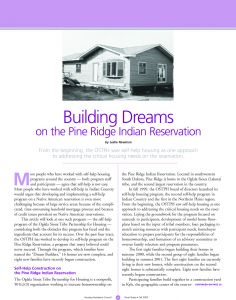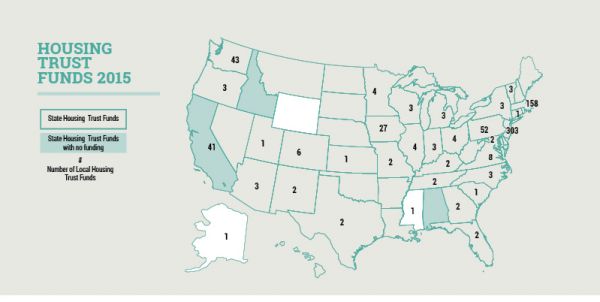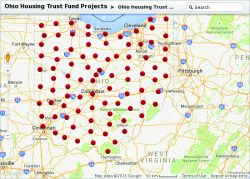Whether growing, stable, or declining, rural communities in the Midwest face challenges in providing housing for low-income residents
by Ann Ziebarth and Jeff Crump
 This story appears in the 2015 Fall Edition of Rural Voices
This story appears in the 2015 Fall Edition of Rural Voices
Small towns in the Midwest face many challenges in providing adequate and affordable housing. Although the popular image of the Midwest is of an idyllic pastoral countryside dotted with small, friendly towns populated with well-kept homes, there are significant problems associated with housing in the region. Many small towns face continuing problems with housing affordability, an older housing stock, and community conflicts over housing issues. Many residents, especially the elderly, poor, and minority households, face difficulties in finding and maintaining decent housing. This brief overview of housing in the rural Midwest region provides a picture of the region’s diversity.
Whether growing, stable, or declining, rural communities in the Midwest face challenges in providing housing for low-income residents
by Ann Xiebarth and Jeff Crump
 This story appears in the 2015 Fall Edition of Rural Voices
This story appears in the 2015 Fall Edition of Rural Voices
Small towns in the Midwest face many challenges in providing adequate and affordable housing. Although the popular image of the Midwest is of an idyllic pastoral countryside dotted with small, friendly towns populated with well-kept homes, there are significant problems associated with housing in the region. Many small towns face continuing problems with housing affordability, an older housing stock, and community conflicts over housing issues. Many residents, especially the elderly, poor, and minority households, face difficulties in finding and maintaining decent housing. This brief overview of housing in the rural Midwest region provides a picture of the region’s diversity.
Rural Midwest Housing Conditions
Compared to the U.S. generally, Midwesterners are more likely to be homeowners. According to the Federal Reserve Bank of St. Louis, the homeownership rate in the second quarter of 2015 for the Midwest was 68.4 percent, nearly 4 percent higher than the overall U.S. rate. In the rural Midwest, homeownership is even higher at 74 percent. In Minnesota and Michigan rural homeownership rates are 77 percent, significantly higher than the overall level of homeownership.
Manufactured homes are an important source of affordable housing in the Midwest and some 1.28 million households reside in manufactured housing. Financing of manufactured homes is often via personal loans rather than typical home mortgages, however, resulting in higher costs and less favorable terms for borrowers. In 2005, 46 percent of all manufactured home loans were high cost loans with interest rates at least 3 percent above those of conventional mortgages. Even though mobile home borrowers have the same repayment records as conventional mortgage holders, they pay more.
The housing boom and bust greatly impacted rural Midwestern residents as the rapid rise of subprime and predatory lending affected buyers in rural communities. The high rates of homeownership and the relatively large number of mobile homes financed with personal loans left many vulnerable when the housing bubble burst in 2007.
Rural mortgage market activity has increased in recent years, but access to mortgage financing remains a problem in rural areas where there is less competition in the mortgage market and lenders assume a higher risk due to smaller market size and remote locations. Moreover, rural borrowers, especially minority persons, experience higher denial rates in the Midwest compared with other regions. Denials are often the result of poor credit histories, lack of collateral, and high debt to income levels, though they may also reflect discrimination in the mortgage market.

While the majority of people in the U.S. own their homes, rental housing remains vitally important. There are more than 7.1 million renter-occupied units in small communities and rural areas, 25 percent of the housing stock. Nearly 40 percent of rural renters are cost-burdened nationwide, paying more than one-third of their gross income for housing. In the Midwest 49.6 percent of renter households are housing cost-burdened. This compares to 29.1 percent of Midwestern homeowner households with mortgages on their homes.
In terms of the physical condition of rural Midwestern housing, the homes Midwesterners occupy are often older and therefore in need of repair and modernization. Thus, housing quality remains a concern across the Midwest and according to the American Housing Survey more than 68,500 rental units and 169,000 owner-occupied units identified are substandard.
Modern agricultural production creates many environmental impacts that affect housing quality in the rural Midwest. For example, the run-off of agriculture pesticides and fertilizers threatens the quality of the groundwater, a particular concern for rural households that rely on wells for their drinking water. In recent years, the development of large-scale livestock confinement facilities has raised concerns over air quality as well. Other common environmental hazards include leaking underground fuel storage tanks, fumigants associated with grain storage areas, and nuclear waste storage sites. An especially prominent example is oil field development in North Dakota where the construction of wells and oilfield waste pits are risking environmental quality and contaminating drinking water.
Rural Midwest Housing Needs
The Midwest’s relatively low housing costs may lead to the misperception that housing is more affordable there. However, housing costs, especially for homeowners, are rising rapidly while property values in many locations have declined. And while the average rents may be lower, the higher cost of utilities often makes housing less affordable. As a result, affordability is an issue throughout the rural Midwest. For example, in one rural county in Minnesota 65 percent of renters were unable to afford a basic two-bedroom apartment.
In places with booming economies, such as the oilfield areas, housing shortages have exacerbated affordability problems. For example, the town of Williston, ND has seen its population more than double in the past four years. An apartment in Williston now costs more than one in New York City. The housing shortages have resulted in a proliferation of temporary housing in RV parks and unsafe living conditions. “Man camps” have sprung up, including the relocation to rural North Dakota of Canada’s Vancouver Olympic Village with dorm-like living quarters for single workers.
Overall, limited incomes and a dearth of affordable housing leave many rural Midwestern households in poor housing situations where they pay excessive proportions of their income for shelter, live in overcrowded or substandard conditions, and in extreme cases face homelessness.
Complicating the situation, second homes are popular among Midwesterners with higher incomes and, as owners retire, vacation homes often become year-round residences. The in-migration of wealthier homeowners converting second homes to year-round living leads to rural gentrification and changes the character of communities. There is a lack of housing opportunities for low-income households, and new construction serves upper-income households. Overall there is a widespread failure of the affordable housing market in these areas. Nonprofit and government organizations attempting to meet housing needs face increasing land costs, higher development expenditures, and greater competition for subsidies and funding, as well as increased local resistance to affordable housing developments.
The growing concentration of elderly residents in the rural Midwest results from both the relocation of retirees and the increased age of those who stay in their homes. Aging in place is common, as many elderly people prefer not to relocate until poor health forces them to do so. However, elderly residents’ homes tend to be of lower quality than rural housing as a whole and, when compared with their urban counterparts, the rural elderly tend to be economically less well off. In particular, many rural elders are in the very oldest age groups where issue of economic support and specialized service needs are most critical.
Providing for elderly residents is especially difficult in communities of less than 2,500. Smaller towns often lack housing alternatives, supportive services, and the medical facilities needed to assist elderly people. To address these needs, the U.S. Department of Agriculture (USDA) has provided home repair loans and grants and has financed rental housing for senior citizens. Thirty percent of all projects funded by USDA’s Section 515 rural rental housing program are located in the Midwest. Due to continuing funding cuts at the federal level, there has not been any new construction of USDA Section 515 rental housing projects since 2011. The limited available funding has been dedicated to preserving the existing available affordable housing. Many of the projects are at the end of their mortgages or are being sold by their owners. For the extremely low-income residents, especially those with rent assistance that is tied to the Section 515 status of their buildings, this potential loss of affordable housing is a serious concern. In addition, many of the buildings need maintenance and upgrades that may have been deferred.
Minority households also face special housing challenges. Whether they are homeowners or renters, minority residents have significant difficulties in obtaining adequate and affordable housing. Native Americans face especially difficult housing conditions and even though only 22 percent of the 5.2 million Native Americans live on tribal lands, for those who do 40 percent of available housing is substandard. Residents of the Pine Ridge Reservation in South Dakota, for example, have an average household income of only $3,500 and 60 percent of the reservation’s 18,000 residents live without electricity or running water. While reservation residents are more likely to be homeowners than the U.S. population as a whole, this statistic can be misleading. On the Dakotas’ Standing Rock Reservation the most recent homeownership rate was 48.8 percent, down from 53.5 percent in 2000. Over the same timeframe the percentage of households facing housing cost burdens increased from 18.5 percent to 23.7 percent. On the Red Lake Reservation in Minnesota, the tribal housing authority has successfully developed and managed 247 units of homes subsidized by the Low-Income Housing Tax Credit and rehabilitated an additional 40 units.

Migrant farmworkers are another group that struggles to obtain safe, decent, and affordable housing. Not only do they have low and unstable incomes, but their jobs require frequent moves, increasing their housing cost and insecurity. Migrant workers frequently live in the least desirable housing within a community – dilapidated mobile homes, garages, barns, and otherwise unsuitable properties. A 2010 report by the Michigan Civil Rights Commission found there were over 35,000 migrant farmworkers in the state and most lived in extremely substandard housing with structural defects, poor sanitation, a lack of clean running water, exposed wires, and overcrowded conditions in close proximity to fields where pesticide hazards were common.
For those who find housing in Midwest labor camps, state inspection and licensing are common. In Illinois, one migrant labor camp located in a village of 13,000 was licensed to house over 400 migrant workers employed by Monsanto Corporation to detassel corn. The housing was located in a converted hospital on a decommissioned military base that was closed in 1993. Across the state 21 licensed labor camps provide housing for a total of 1,970 workers. Nonprofit organizations such as UMOS in Wisconsin have also provided decent seasonal rental housing for families as well as housing counseling, education, a voucher program for homeless individuals, and technical assistance across 15 Midwest states. In Minnesota, a state level Migrant Labor Demonstration Program was developed using matching grants funded through housing finance agency bonds. The program was discontinued two years later due to the lack of interest by employers in improving their worker housing. Yet housing quality for migrant and seasonal workers and their families remains a problem.
Migrants with year round employment also face a severe shortage of housing. For example, large dairy farms employ many immigrants who need on-farm housing or accommodations within a short distance of the farm. The expansion of meatpacking industries in the Midwest has attracted numerous immigrants and resulted in increased demand for housing, as well as changed dramatically the demographic profile of some rural communities. In rural Iowa and Nebraska, substantial increases in Hispanic residents have been documented. In Minnesota and Illinois, refugees and immigrants from Cambodia, Laos, Somalia, and Bosnia are filling low-wage, low-skill jobs in rural communities. New workers relocating to Midwest meatpacking towns have found that housing is particularly difficult to obtain. Workers end up homeless, in temporary “sleeping rooms,” or in company-owned deteriorating mobile homes. The influx of immigrants has resulted in conflicts over cultural differences in lifestyle and increasing incidences of housing segregation and/or discrimination.
Meeting the Needs
Resolving the housing needs in the rural Midwest depends not only on the housing stock itself, but also on the processes that support its construction, maintenance, and continued affordability. There are a number of challenges for Midwest developers. The high cost of materials, transportation, and utilities raises the overall cost of new construction. In many places there is a lack of skilled construction workers including plumbers, electricians, and finish carpenters. Most multifamily rental housing built in the U.S. today is subsidized through government programs, but cuts in federal funding have limited the availability of subsidies in rural areas. Many developers find more profitable work in metropolitan or rapidly growing areas where economies of scale in large projects are possible. In small towns needing just a few units, attracting contractors and builders is a challenge. This in turn inhibits local industry expansion. In Roseau, MN, for example, employers with 300 temporary workers and a desire to hire 200 more are stymied because wages cannot support the high rents needed to cover the costs of building new apartments without a subsidy. To pay off the mortgage of a new project would require rents of at least $1,200 beyond what the market will bear.
New housing developments depend partially on the social capital or community capacity of localities. Part-time officials and limited budgets often hamper the ability of rural communities to address local housing needs. The professional expertise to plan, apply for, and conduct programs of housing and community development is often lacking. The self-sufficient, “getting by on our own” attitude among rural Midwesterners can further hinder the provision of better housing, especially where local decision-makers are unaware of or unwilling to address the problem. Even when these barriers are overcome, small communities often find that economies of scale are difficult to achieve given a limited and widely scattered population and a low tax base. In spite of these obstacles, a number of rural communities throughout the Midwest have provided innovative local solutions to community housing needs.
Nonprofit housing organizations are a key component to providing affordable housing in rural communities. For example, the Southwest Minnesota Housing Partnership (SMHP) has successfully built new multifamily rental and single-family homes across a 17-county area. The partnership has creatively adapted an abandoned school into housing units and purchased blighted units for rehabilitation. In addition, the SMHP supports homeownership through educational and financing programs and by providing funding for home repairs.
Cooperative housing is one means of providing affordable ownership and control among low-income and elderly residents. Over 1 million families find cooperative homes a pleasing and affordable housing option. In the Midwest cooperative housing, especially for senior citizens, is a popular option. Cooperatives allow resident members to own and control their homes. Of the nation’s 103 housing cooperatives designed for seniors, 79 are located in Minnesota.
Cooperative ownership has also become an alternative to paying lot rent for six mobile home communities in Minnesota and two in Wisconsin. At Sunrise Villa Cooperative in Cannon Falls, MN, 47 homeowners cooperatively own their manufactured home community’s land financed with a long-term, fixed rate, low-interest loan through the Minnesota Housing Finance Agency. In Madelia, MN a mobile home village cooperative houses 62 families of whom 95 percent are Latino. The cooperative members have improved their communities adding bus shelters for children, playgrounds, improved landscaping, and garages.
Recently employers have become increasingly concerned about housing as a key component in attracting and keeping workers. Midwest firms are partners in housing development projects with local governments and nonprofit organizations. For example, in rural Minnesota Schwann’s Food Company contributed to the construction of 82 rental units and 150 single-family dwellings between 2001 and 2007 and Polaris Industries and Marvin Windows provided partial funding for 40 rental units and 10 single-family homes. In addition, it is becoming more common for private firms to offer housing-related benefits for their employees.
Rapidly growing rural communities in the Midwest, especially those near urban centers or in areas with natural amenities, are struggling to meet the increasing demand for affordable housing. Both stable communities and those that are declining find their housing concerns focused on maintaining the quality of their housing stock and providing housing alternatives for senior citizens. The diversity of rural housing needs results in a challenge for those who provide technical assistance, allocate funding, and advocate for improved housing conditions.
Ann Ziebarth and Jeff Crump are Professors at the University of Minnesota, Housing Studies Program.
 This story appears in the 2015 Fall Edition of Rural Voices
This story appears in the 2015 Fall Edition of Rural Voices This story appears in the 2015 Fall Edition of Rural Voices
This story appears in the 2015 Fall Edition of Rural Voices
 In fall 2003, we looked at a new self-help housing program on the Pine Ridge Indian Reservation, developed by the Oglala Sioux Tribe Partnership for Housing (OSTPH). We looked at what it took to create the program, some challenges to self-help housing on tribal trust land, and ingredients for success.
In fall 2003, we looked at a new self-help housing program on the Pine Ridge Indian Reservation, developed by the Oglala Sioux Tribe Partnership for Housing (OSTPH). We looked at what it took to create the program, some challenges to self-help housing on tribal trust land, and ingredients for success.





